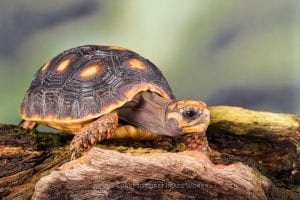Red footed tortoises are a tropical species originating from northern regions of South America. For this reason they are very different in many ways to their cousins such as Spur-Thighed and Hermanns tortoises. In the wild they live in areas of high humidity, receive more dappled sunlight and UVB and feed on more fallen fruit (and even carrion) than Spur-Thighed or Hermanns.
While all species of tortoises are not generally ideally kept outdoors permanently in the UK (especially without supplementary heating) this species is completely unsuitable – it has very specific requirements. As it is a larger species of tortoise it is for this reason we suggest a lot of thought is put into whether a potential keeper can provide what they need. Keeping a larger sized tortoise indoors can be tricky, even if its just due to the space required – a small room would be ideal.
For a youngster you will require a four feet long vivarium fitted with overhead heating – we use ceramic heaters, some keepers prefer halogen and  incandescent light bulbs. If light emitting light bulbs are used this species requires a relatively high night-time temperature, so provision for night time heating will be required – in this case it would be likely a keeper would use both a halogen / incandescent for day time and a ceramic heater for night time. We find a ceramic, in conjunction with a high output T5 UVB tube is ideal for them during the day, as the T5 light output is much higher than any halogen or incandescent bulb. Daytime temperatures are ideal at around a basking temperature of 32C, dropping to an ambient night-time of around 24C. The newer T5 UVB’s are highly recommended, again a personal choice on power level, we would suggest no higher than a 10{cb5d0a8cf0c44aef2db327d9ab0dba08dd09aed1126b509e5fa01d3aaa87fe47}, as this species lives on forest floors many keepers prefer a lower output, such as Arcadia ShadeDweller 7{cb5d0a8cf0c44aef2db327d9ab0dba08dd09aed1126b509e5fa01d3aaa87fe47}.
incandescent light bulbs. If light emitting light bulbs are used this species requires a relatively high night-time temperature, so provision for night time heating will be required – in this case it would be likely a keeper would use both a halogen / incandescent for day time and a ceramic heater for night time. We find a ceramic, in conjunction with a high output T5 UVB tube is ideal for them during the day, as the T5 light output is much higher than any halogen or incandescent bulb. Daytime temperatures are ideal at around a basking temperature of 32C, dropping to an ambient night-time of around 24C. The newer T5 UVB’s are highly recommended, again a personal choice on power level, we would suggest no higher than a 10{cb5d0a8cf0c44aef2db327d9ab0dba08dd09aed1126b509e5fa01d3aaa87fe47}, as this species lives on forest floors many keepers prefer a lower output, such as Arcadia ShadeDweller 7{cb5d0a8cf0c44aef2db327d9ab0dba08dd09aed1126b509e5fa01d3aaa87fe47}.
 Food is a mix of greens such as dandelion leaves (supermarket produce should be used sparingly, but kale is relatively good) and ripe fruit. As they eat carrion in the wild this can be replicated with commercially available defrosted frozen rat pups. Always use a good quality reptile balanced vitamin and mineral supplement.
Food is a mix of greens such as dandelion leaves (supermarket produce should be used sparingly, but kale is relatively good) and ripe fruit. As they eat carrion in the wild this can be replicated with commercially available defrosted frozen rat pups. Always use a good quality reptile balanced vitamin and mineral supplement.
